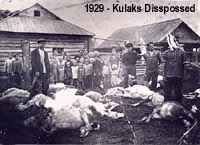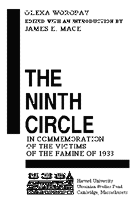Drought 1931-32:
Drought in 1931, and again in 1932, over wide areas of the grain-growing
regions aggravated the problem. But the government, determined to maintain
food supplies for its factory workers, and even more determined to whip
the peasants into line, insisted on collecting its quota of grain, crop
or no crop. Seed grain was removed and put in storage in cities --a move
which shows authorities were concerned at protecting seed grain from hungry
peasants who surely would have eaten it had they access to it. At the height
of the famine, Troops were sent in to collect the grain.
By the late summer of 1932 there were no grain reserves left in many
parts of the Volga region, the Ukraine, and the North Caucasus. Hunger
stalked the land, killing peasants by the millions. No relief food was
sent into the hunger areas, no foreign aid was requested or permitted.
In fact the existence of a famine was denied by the regime even while it
was happening mainly to signal the "triumphal" end of the first five-year
plan. This man-made famine of 1933 was undoubtedly the most inhuman of
Stalin's crimes. But it ended the collectivization debate. The peasants
now admitted defeat.
The death toll was staggering. It's estimated 7 million people died
from famine in 1932-33, and an additional 7.5 million died from de-kulakization
and other state violence from 1930-37. |





